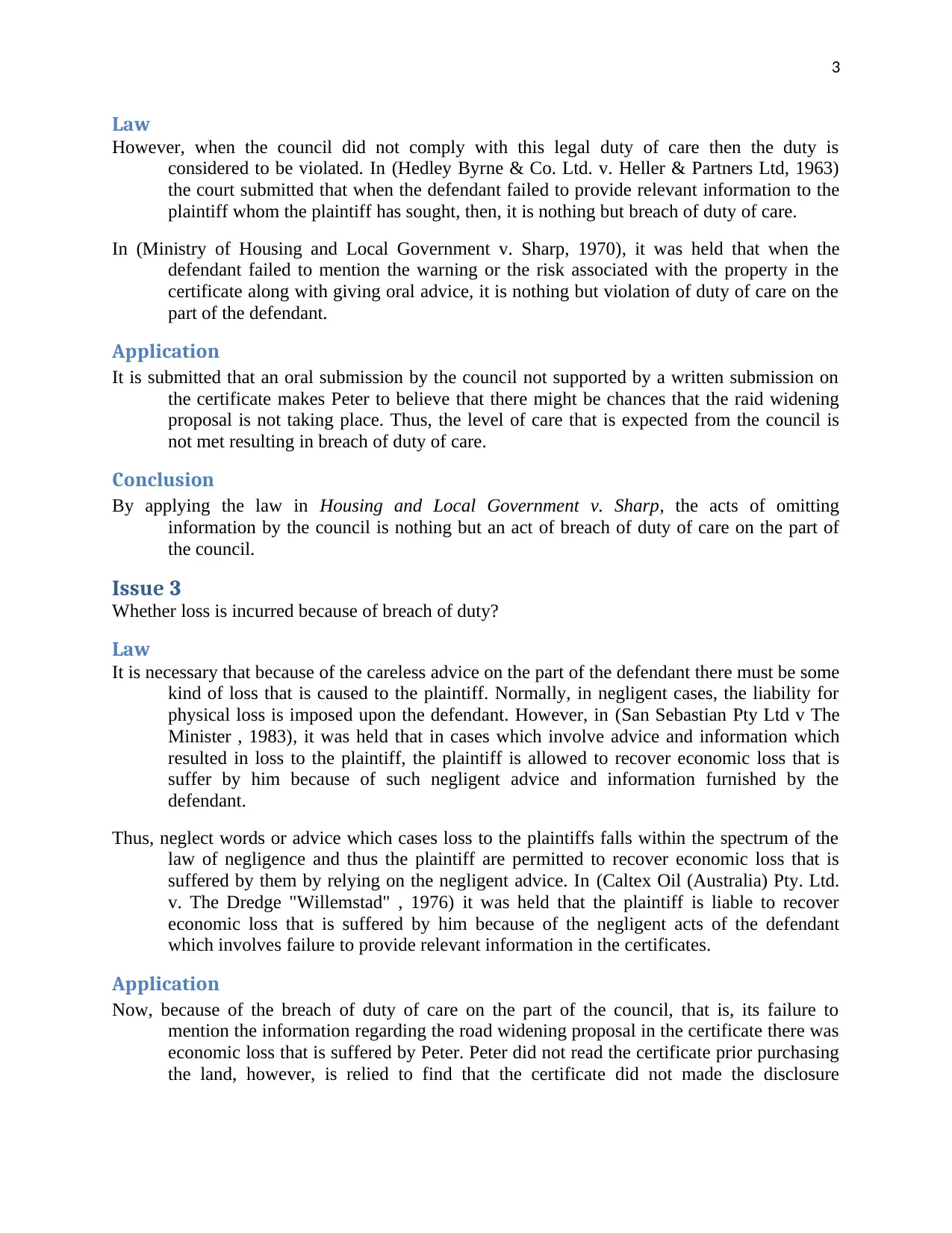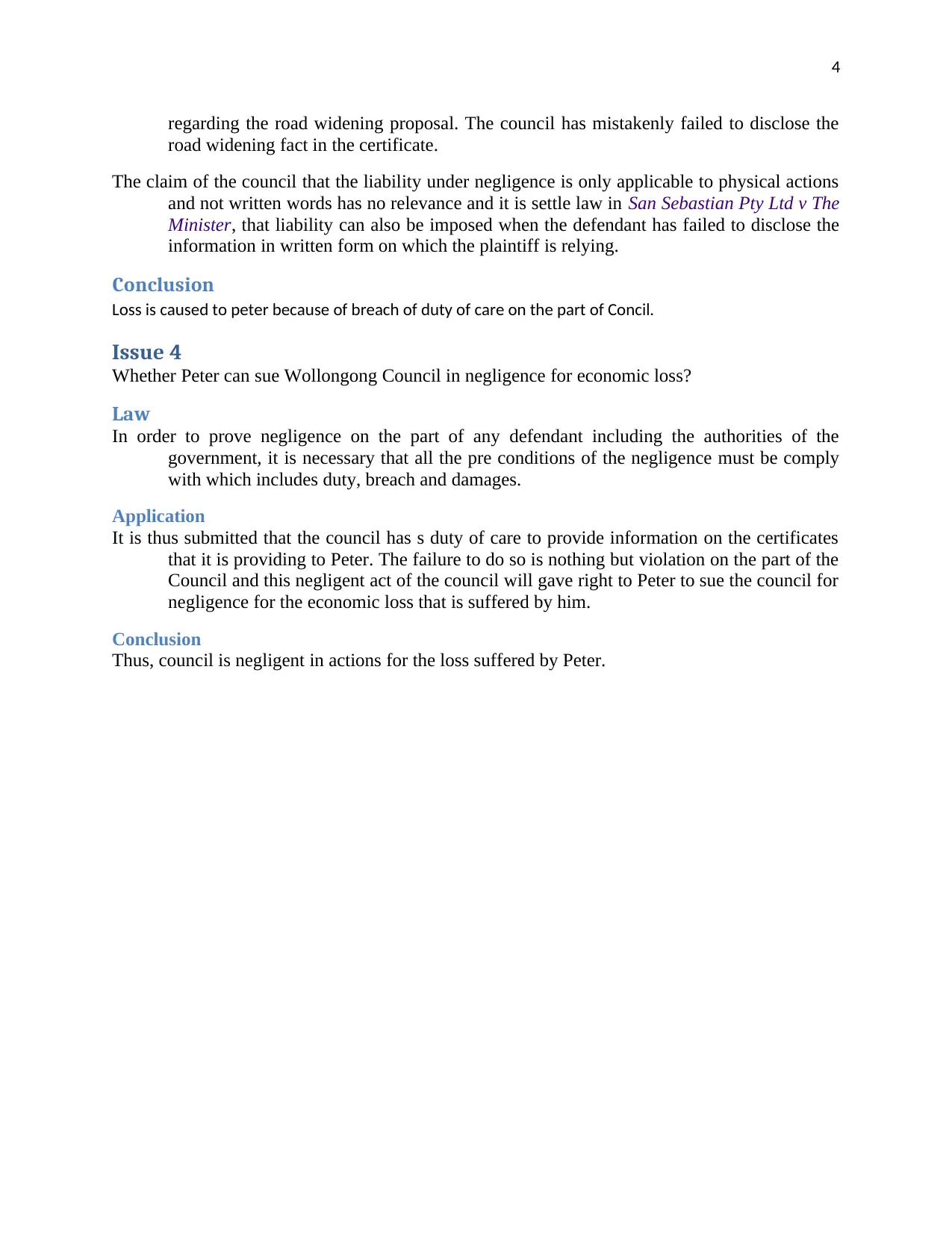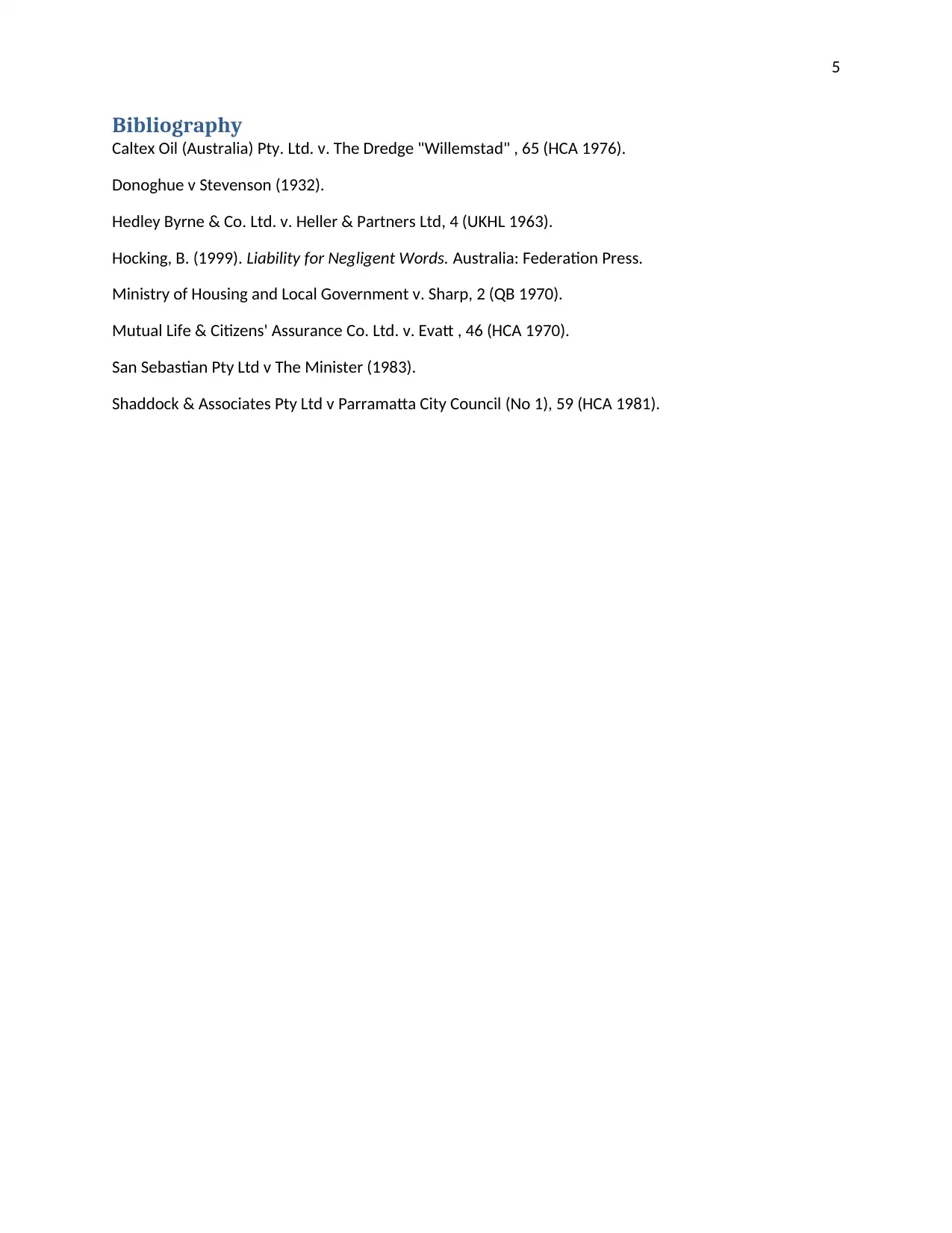Analysis of Wollongong Council's Duty of Care in a Negligence Case
VerifiedAdded on 2021/06/18
|5
|1385
|31
Case Study
AI Summary
This case study analyzes a legal dispute involving the Wollongong Council and Peter, a property developer. Peter purchased land based on a council certificate that failed to disclose a road widening proposal, leading to a significant reduction in the land's value. The analysis focuses on whether the council owed Peter a duty of care, whether that duty was breached by the omission of critical information, and whether the resulting economic loss is recoverable. The assignment references key legal precedents, including Donoghue v Stevenson, Shaddock & Associates Pty Ltd v Parramatta City Council (No 1), and San Sebastian Pty Ltd v The Minister, to establish the principles of duty of care, breach, and the recovery of economic loss in negligence claims. The conclusion affirms that the council was negligent in its actions, and Peter is entitled to sue for the economic damages incurred due to the council's failure to provide accurate information.

1
Contents
Solution.......................................................................................................................................................2
Issue 1..........................................................................................................................................................2
Law..........................................................................................................................................................2
Application..............................................................................................................................................2
Conclusion...............................................................................................................................................2
Issue 2..........................................................................................................................................................2
Law..........................................................................................................................................................3
Application..............................................................................................................................................3
Conclusion...............................................................................................................................................3
Issue 3..........................................................................................................................................................3
Law..........................................................................................................................................................3
Application..............................................................................................................................................3
Conclusion...............................................................................................................................................4
Issue 4..........................................................................................................................................................4
Law..........................................................................................................................................................4
Application..............................................................................................................................................4
Conclusion...............................................................................................................................................4
Bibliography................................................................................................................................................5
Contents
Solution.......................................................................................................................................................2
Issue 1..........................................................................................................................................................2
Law..........................................................................................................................................................2
Application..............................................................................................................................................2
Conclusion...............................................................................................................................................2
Issue 2..........................................................................................................................................................2
Law..........................................................................................................................................................3
Application..............................................................................................................................................3
Conclusion...............................................................................................................................................3
Issue 3..........................................................................................................................................................3
Law..........................................................................................................................................................3
Application..............................................................................................................................................3
Conclusion...............................................................................................................................................4
Issue 4..........................................................................................................................................................4
Law..........................................................................................................................................................4
Application..............................................................................................................................................4
Conclusion...............................................................................................................................................4
Bibliography................................................................................................................................................5
Paraphrase This Document
Need a fresh take? Get an instant paraphrase of this document with our AI Paraphraser

2
Solution
Issue 1
Whether the Wollongong Council is imposed with duty of care against Peter?
Law
In negligence, every defendant owns a duty of care against the plaintiff, violation of which
results in making the defendant negligent in his actions. The law was rightly developed in
(Donoghue v Stevenson , 1932). (Hocking, 1999)
In order to prove negligence on the part of any defendant including the authorities of the
government, it is necessary that all the pre conditions of the negligence must be comply
with which includes duty, breach and damages.
This legal duty of care is imposed on the council when a plaintiff is relying on the information
prior entering into any contractual relationship with the council.
In (Mutual Life & Citizens' Assurance Co. Ltd. v. Evatt , 1970), it was held by the courts that
when any council is giving advice to the plaintiff and is of the view that the plaintiff will
rely on such advice, then, the council owns a duty of care against such plaintiff.
When any defendant possesses special skill and knowledge then it becomes its paramount duty to
provide the information adequately considering the fact that the plaintiff is relying on the
sense of judgment of the defendant. In (Shaddock & Associates Pty Ltd v Parramatta City
Council (No 1), 1981), the legal duty of care is imposed on the council to provide
relevant information to the plaintiff.
Application
Peter develops residential apartment in the Wollongong local area and thus purchased a large
block @$2 million to built complex at a profit. However, the Wollongong Council did
not approve the application of Peter as there was a road widening proposal that will
reduce the size of the block and the cost of land to $1 million. Before the purchase of the
land, he received a certificate from the council in which there was no disclosure
regarding the road widening poplar.
Wollongong Council is in a special relationship with Peter. There is a duty of care that can be
imposed upon the council to provide adequate information to Peter regarding the road
widening proposal considering the fact that if adequate information is not provided the
Peter might suffer harm. Thus, council owns a duty of care against Peter.
Conclusion
By applying the law in Shaddock & Associates Pty Ltd v Parramatta City Council (No 1) the
duty exist as the council and the Peter are in special relationship.
Issue 2
Whether the said duty is violated?
Solution
Issue 1
Whether the Wollongong Council is imposed with duty of care against Peter?
Law
In negligence, every defendant owns a duty of care against the plaintiff, violation of which
results in making the defendant negligent in his actions. The law was rightly developed in
(Donoghue v Stevenson , 1932). (Hocking, 1999)
In order to prove negligence on the part of any defendant including the authorities of the
government, it is necessary that all the pre conditions of the negligence must be comply
with which includes duty, breach and damages.
This legal duty of care is imposed on the council when a plaintiff is relying on the information
prior entering into any contractual relationship with the council.
In (Mutual Life & Citizens' Assurance Co. Ltd. v. Evatt , 1970), it was held by the courts that
when any council is giving advice to the plaintiff and is of the view that the plaintiff will
rely on such advice, then, the council owns a duty of care against such plaintiff.
When any defendant possesses special skill and knowledge then it becomes its paramount duty to
provide the information adequately considering the fact that the plaintiff is relying on the
sense of judgment of the defendant. In (Shaddock & Associates Pty Ltd v Parramatta City
Council (No 1), 1981), the legal duty of care is imposed on the council to provide
relevant information to the plaintiff.
Application
Peter develops residential apartment in the Wollongong local area and thus purchased a large
block @$2 million to built complex at a profit. However, the Wollongong Council did
not approve the application of Peter as there was a road widening proposal that will
reduce the size of the block and the cost of land to $1 million. Before the purchase of the
land, he received a certificate from the council in which there was no disclosure
regarding the road widening poplar.
Wollongong Council is in a special relationship with Peter. There is a duty of care that can be
imposed upon the council to provide adequate information to Peter regarding the road
widening proposal considering the fact that if adequate information is not provided the
Peter might suffer harm. Thus, council owns a duty of care against Peter.
Conclusion
By applying the law in Shaddock & Associates Pty Ltd v Parramatta City Council (No 1) the
duty exist as the council and the Peter are in special relationship.
Issue 2
Whether the said duty is violated?

3
Law
However, when the council did not comply with this legal duty of care then the duty is
considered to be violated. In (Hedley Byrne & Co. Ltd. v. Heller & Partners Ltd, 1963)
the court submitted that when the defendant failed to provide relevant information to the
plaintiff whom the plaintiff has sought, then, it is nothing but breach of duty of care.
In (Ministry of Housing and Local Government v. Sharp, 1970), it was held that when the
defendant failed to mention the warning or the risk associated with the property in the
certificate along with giving oral advice, it is nothing but violation of duty of care on the
part of the defendant.
Application
It is submitted that an oral submission by the council not supported by a written submission on
the certificate makes Peter to believe that there might be chances that the raid widening
proposal is not taking place. Thus, the level of care that is expected from the council is
not met resulting in breach of duty of care.
Conclusion
By applying the law in Housing and Local Government v. Sharp, the acts of omitting
information by the council is nothing but an act of breach of duty of care on the part of
the council.
Issue 3
Whether loss is incurred because of breach of duty?
Law
It is necessary that because of the careless advice on the part of the defendant there must be some
kind of loss that is caused to the plaintiff. Normally, in negligent cases, the liability for
physical loss is imposed upon the defendant. However, in (San Sebastian Pty Ltd v The
Minister , 1983), it was held that in cases which involve advice and information which
resulted in loss to the plaintiff, the plaintiff is allowed to recover economic loss that is
suffer by him because of such negligent advice and information furnished by the
defendant.
Thus, neglect words or advice which cases loss to the plaintiffs falls within the spectrum of the
law of negligence and thus the plaintiff are permitted to recover economic loss that is
suffered by them by relying on the negligent advice. In (Caltex Oil (Australia) Pty. Ltd.
v. The Dredge "Willemstad" , 1976) it was held that the plaintiff is liable to recover
economic loss that is suffered by him because of the negligent acts of the defendant
which involves failure to provide relevant information in the certificates.
Application
Now, because of the breach of duty of care on the part of the council, that is, its failure to
mention the information regarding the road widening proposal in the certificate there was
economic loss that is suffered by Peter. Peter did not read the certificate prior purchasing
the land, however, is relied to find that the certificate did not made the disclosure
Law
However, when the council did not comply with this legal duty of care then the duty is
considered to be violated. In (Hedley Byrne & Co. Ltd. v. Heller & Partners Ltd, 1963)
the court submitted that when the defendant failed to provide relevant information to the
plaintiff whom the plaintiff has sought, then, it is nothing but breach of duty of care.
In (Ministry of Housing and Local Government v. Sharp, 1970), it was held that when the
defendant failed to mention the warning or the risk associated with the property in the
certificate along with giving oral advice, it is nothing but violation of duty of care on the
part of the defendant.
Application
It is submitted that an oral submission by the council not supported by a written submission on
the certificate makes Peter to believe that there might be chances that the raid widening
proposal is not taking place. Thus, the level of care that is expected from the council is
not met resulting in breach of duty of care.
Conclusion
By applying the law in Housing and Local Government v. Sharp, the acts of omitting
information by the council is nothing but an act of breach of duty of care on the part of
the council.
Issue 3
Whether loss is incurred because of breach of duty?
Law
It is necessary that because of the careless advice on the part of the defendant there must be some
kind of loss that is caused to the plaintiff. Normally, in negligent cases, the liability for
physical loss is imposed upon the defendant. However, in (San Sebastian Pty Ltd v The
Minister , 1983), it was held that in cases which involve advice and information which
resulted in loss to the plaintiff, the plaintiff is allowed to recover economic loss that is
suffer by him because of such negligent advice and information furnished by the
defendant.
Thus, neglect words or advice which cases loss to the plaintiffs falls within the spectrum of the
law of negligence and thus the plaintiff are permitted to recover economic loss that is
suffered by them by relying on the negligent advice. In (Caltex Oil (Australia) Pty. Ltd.
v. The Dredge "Willemstad" , 1976) it was held that the plaintiff is liable to recover
economic loss that is suffered by him because of the negligent acts of the defendant
which involves failure to provide relevant information in the certificates.
Application
Now, because of the breach of duty of care on the part of the council, that is, its failure to
mention the information regarding the road widening proposal in the certificate there was
economic loss that is suffered by Peter. Peter did not read the certificate prior purchasing
the land, however, is relied to find that the certificate did not made the disclosure
⊘ This is a preview!⊘
Do you want full access?
Subscribe today to unlock all pages.

Trusted by 1+ million students worldwide

4
regarding the road widening proposal. The council has mistakenly failed to disclose the
road widening fact in the certificate.
The claim of the council that the liability under negligence is only applicable to physical actions
and not written words has no relevance and it is settle law in San Sebastian Pty Ltd v The
Minister, that liability can also be imposed when the defendant has failed to disclose the
information in written form on which the plaintiff is relying.
Conclusion
Loss is caused to peter because of breach of duty of care on the part of Concil.
Issue 4
Whether Peter can sue Wollongong Council in negligence for economic loss?
Law
In order to prove negligence on the part of any defendant including the authorities of the
government, it is necessary that all the pre conditions of the negligence must be comply
with which includes duty, breach and damages.
Application
It is thus submitted that the council has s duty of care to provide information on the certificates
that it is providing to Peter. The failure to do so is nothing but violation on the part of the
Council and this negligent act of the council will gave right to Peter to sue the council for
negligence for the economic loss that is suffered by him.
Conclusion
Thus, council is negligent in actions for the loss suffered by Peter.
regarding the road widening proposal. The council has mistakenly failed to disclose the
road widening fact in the certificate.
The claim of the council that the liability under negligence is only applicable to physical actions
and not written words has no relevance and it is settle law in San Sebastian Pty Ltd v The
Minister, that liability can also be imposed when the defendant has failed to disclose the
information in written form on which the plaintiff is relying.
Conclusion
Loss is caused to peter because of breach of duty of care on the part of Concil.
Issue 4
Whether Peter can sue Wollongong Council in negligence for economic loss?
Law
In order to prove negligence on the part of any defendant including the authorities of the
government, it is necessary that all the pre conditions of the negligence must be comply
with which includes duty, breach and damages.
Application
It is thus submitted that the council has s duty of care to provide information on the certificates
that it is providing to Peter. The failure to do so is nothing but violation on the part of the
Council and this negligent act of the council will gave right to Peter to sue the council for
negligence for the economic loss that is suffered by him.
Conclusion
Thus, council is negligent in actions for the loss suffered by Peter.
Paraphrase This Document
Need a fresh take? Get an instant paraphrase of this document with our AI Paraphraser

5
Bibliography
Caltex Oil (Australia) Pty. Ltd. v. The Dredge "Willemstad" , 65 (HCA 1976).
Donoghue v Stevenson (1932).
Hedley Byrne & Co. Ltd. v. Heller & Partners Ltd, 4 (UKHL 1963).
Hocking, B. (1999). Liability for Negligent Words. Australia: Federation Press.
Ministry of Housing and Local Government v. Sharp, 2 (QB 1970).
Mutual Life & Citizens' Assurance Co. Ltd. v. Evatt , 46 (HCA 1970).
San Sebastian Pty Ltd v The Minister (1983).
Shaddock & Associates Pty Ltd v Parramatta City Council (No 1), 59 (HCA 1981).
Bibliography
Caltex Oil (Australia) Pty. Ltd. v. The Dredge "Willemstad" , 65 (HCA 1976).
Donoghue v Stevenson (1932).
Hedley Byrne & Co. Ltd. v. Heller & Partners Ltd, 4 (UKHL 1963).
Hocking, B. (1999). Liability for Negligent Words. Australia: Federation Press.
Ministry of Housing and Local Government v. Sharp, 2 (QB 1970).
Mutual Life & Citizens' Assurance Co. Ltd. v. Evatt , 46 (HCA 1970).
San Sebastian Pty Ltd v The Minister (1983).
Shaddock & Associates Pty Ltd v Parramatta City Council (No 1), 59 (HCA 1981).
1 out of 5
Related Documents
Your All-in-One AI-Powered Toolkit for Academic Success.
+13062052269
info@desklib.com
Available 24*7 on WhatsApp / Email
![[object Object]](/_next/static/media/star-bottom.7253800d.svg)
Unlock your academic potential
Copyright © 2020–2025 A2Z Services. All Rights Reserved. Developed and managed by ZUCOL.





